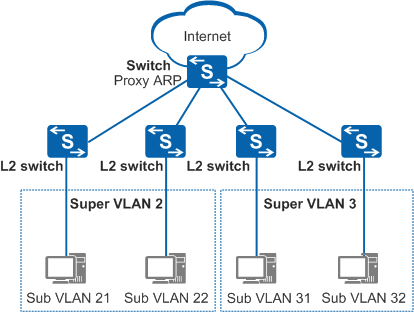Application Scenarios for VLAN Aggregation
In Figure 1, an enterprise has multiple departments that connect to the Internet through different switches. For security purposes, the enterprise adds different departments to different VLANs. However, the number of available IP addresses is limited.
The requirements are as follows:
- All departments require access to the Internet.
- Department 1 and department 2 need to communicate with each other.
- Department 3 and department 4 need to communicate with each other.
VLAN aggregation and proxy ARP can be used to meet the preceding requirements. Deploy super-VLAN 2 and super-VLAN 3 on the switch, and add sub-VLAN 21 and sub-VLAN 22 to super-VLAN 2 and sub-VLAN 31 and sub-VLAN 32 to super-VLAN 3. After IP addresses are assigned to super-VLAN 2 and super-VLAN 3 on the switch, users in department 1 and department 2 can access the Internet using the IP address of super-VLAN 2, and users in department 3 and department 4 can access the Internet using the IP address of super-VLAN 3.
Therefore, VLAN aggregation allows all departments to access the Internet access and conserves IP addresses.
To allow communication between departments 1 and 2 and departments 3 and 4, configure proxy ARP on the switch in super-VLAN 2 and super-VLAN 3.
